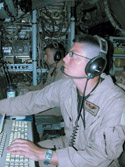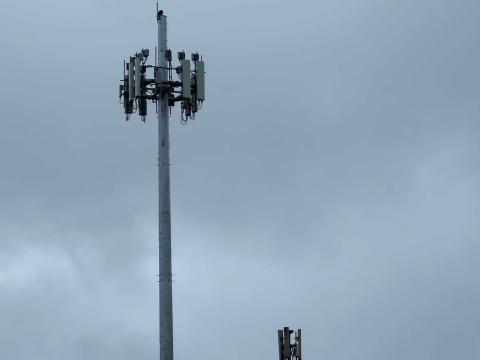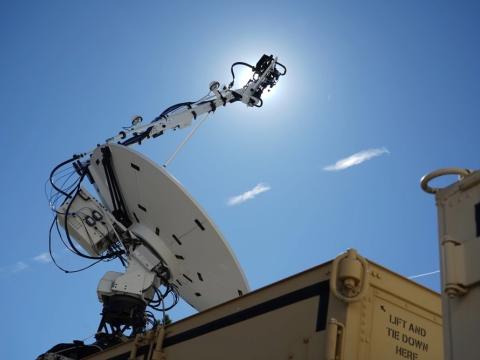Iraq Hones Army Electronic Warfare
 |
| A U.S. Air Force electronic warfare (EW) officer eyes a display aboard a Rivet Joint aircraft flying over Southwest Asia. The U.S. Army is tapping EW expertise from the Air Force and the U.S. Navy to develop its own EW capability, which already is having an effect on operations in Iraq. |
Instead of hosting the mother of all battles, the Iraq War has proved to be the mother of invention for U.S. Army electronic warfare. Faced with the necessity of countering improvised explosive devices, or IEDs, the Army has committed to developing a full-scale electronic warfare capability that will be distributed throughout the entire force. That capability already has achieved a measure of success in
The Army electronic warfare, or EW, effort has been characterized by failures and successes amid close cooperation with the other services. Army personnel are learning the craft in joint billets, and the other services are lending expertise and assets to help the Army build a strong EW foundation. But even the long-term Army EW efforts are taking place against the backdrop of the Iraq War and the adversaries’ use of IEDs against ground forces there.
It was barely a year ago that the Army stood up an EW division under the G-3 in the Army staff. This placed it in an operational environment where it could have significant influence on many Army disciplines, including kinetic activities such as fires. So, soldiers and field artillery officers can be the chief bearers of EW in the Army’s transformational brigade combat team configuration. Fires personnel will be responsible for the integration of EW effects.
Col. Laurie Moe Buckhout, USA, chief of the Army EW division, points out that this makes EW a weapon system of choice over which the field artillery officer has command and control. The other services integrate EW systems under the EW Coordination Center, or EWCC. This ensures a joint doctrine, and the Army’s adoption of a similar approach will help interoperability.
The Army’s new approach to EW represents a bit of a turnaround. Whereas the service had little to do with EW for many years, it now is emphasizing its importance both tactically and organizationally. Col. Buckhout explains that the Army has dedicated EW as a core competency, so every soldier must have an understanding of EW. The Army also is building a core of EW experts in the enlisted, warrant and commissioned ranks.
Army EW will be an aspect of the service’s modularity in that these experts will be embedded throughout the Army in all echelons. Some organizations will include EW teams, the colonel adds.
The colonel allows that the Army’s new emphasis on EW emerged from the fight against IEDs in
Electronic attack entails offensive action against an adversary. This could range from suppressing air defenses to employing radio traffic countermeasures. Electronic protect defends Army assets against enemy electronic attacks, which could include direct methods such as jamming or indirect kinetic methods such as setting IEDs. And, signals intelligence must be integrated into EW to increase the efficiency of both disciplines.
Staying ahead of the enemy is the chief tactical challenge facing Army EW, Col. Buckhout states. The enemy in
But recently the Army has been able to turn the tide in EW. It has been able to use EW for targeting and for surgically interdicting specific operators without interfering with other users of the local electromagnetic spectrum.
These successes emerged from earlier efforts that achieved mixed results. Those efforts mainly involved brute-force EW against the IED spectrum instead of actions targeted against specific threats. Electronic countermeasures systems pressed into action against IEDs were not designed for crowded urban environments rife with various radio frequency systems. Many of these early counter-IED efforts interfered with friendly spectrum, both military and civilian.
Satellite, FM and cell phone systems all suffered from some of these jamming measures. The military found that its vital global positioning system (GPS) and communications systems, including Blue Force Tracking, were disabled when these IED jammers were operating. Iraqi emergency responders, such as Red Crescent ambulance staff, could not use their communications systems. Civilians who relied on cell phone connectivity for their day-to-day existence were cut off, and even helicopters and aircraft could be affected locally.
But a key tactical success in the EW counter-IED effort was the refinement of materiel, techniques and operations, Col. Buckhout states. Those interference issues have been largely resolved, so the Army now can counter enemy IEDs more effectively while maintaining vital communications and radio frequency systems. “We have come a long way in technologies and capabilities to address the threat while enabling our own friendly use of the spectrum,” she states. “We have had great successes countering certain types of IEDs by denying the enemy use of the spectrum.
“Because of electronic warfare, we are able to more surgically affect hostile operations,” the colonel declares. “We can go directly after a threat while impacting less of the spectrum writ large. So you’re having less collateral damage on overall systems that are friendly or have the potential to be friendly, and a more surgical effect going directly after enemy systems.”
However, interoperability remains an issue, particularly with other services’ EW activities. Not all friendly communications systems are immune from EW conflict. And, many forces still lack sufficient equipment to counter IEDs despite accelerated production lines.
On the technology front for the current fight, the Army needs more spectrum-efficient technology for both electronic attack and electronic support. Increased interoperability remains high on the EW wish list. And, more agile systems will help electronic warfare activities. Col. Buckhout cites the use of networked emitters and sensors as one approach to providing effective EW for theater forces.
Some of the issues confronting Army EW in
A construct in the Multinational Corps Iraq (MNCI) connects intelligence personnel with the EW targeting process. Not only does this help avoid spectrum conflict, it also improves EW effectiveness. The MNCI group has established tactics, techniques and procedures, and the Army is developing long-term policies and doctrine for coordinating efforts among intelligence elements and EW practitioners.
The Army is tapping the other services’ EW expertise. The MNCI employs joint EW assets. The U.S. Navy has provided a number of EW officers to help the Army in
One example of this joint approach is an Air Force officer who was trained in EW by the Navy to serve as an Army EW officer in
The Air Force major went through two Navy EW schools before receiving Army combat training. These efforts heightened his understanding of the cultural differences among the services, and this understanding helped him adjust to the Army method of operations when he brought his own expertise to bear in the field. For example, he notes that the Army tends to look less for ideal solutions than to make the most of what it has at hand. This “cross-pollination” between the Army and Air Force is likely to grow as jointness increases, he adds.
Maj. Quaid’s expertise in the space arena is useful for an EW officer, he offers. His knowledge of space operations is not normally the purview of a ground EW officer, and many of those vital space capabilities go untapped for lack of awareness on the part of the customer. That is not the case when he is with the Army in the field. Similarly, when the major would have a problem with a specific system, he often could reach back to his contacts in the space operations field for useful advice. Sometimes these space experts could direct the major or even help cut through red tape to get him the assistance he needed, particularly in areas of commonality. “There is a lot of synergy between space operations and other capabilities such as electronic warfare,” he declares.
Select Army battalions in
The environment in
Tactical EW challenges may be similar to those in
Even in this less-technology-driven Afghan environment, the EW mission is accorded great importance by the Army, the major states, adding that it is one of the reasons that the service has invited the Air Force to work with it on EW. “The Army absolutely wants the best capability that it can get, so to that end it is very open-minded to new capabilities,” he adds.
The major has noted the greater emphasis that the Army is placing on EW, particularly at the tactical level. It is clear that the goal is for the Army to be self-sufficient in EW without having to rely on the Air Force or Navy, and this will help all three participate in joint EW operations. “I’m an Air Force officer trained by the Navy to assist an Army battalion-level operation,” he relates. “I think that is the poster child for jointness.”
This assistance from other services also is addressing a major change that is not yet complete. The new emphasis on EW is forcing the Army to undergo a cultural shift, Col. Buckhout states. Getting soldiers to fight on the spectrum requires that they shift from a heavy reliance on kinetic weapons in favor of direct action in the electronic spectrum that may be nonlethal. “Every battalion and higher organization going into theater will have at least one Army-trained EWO with it,” she observes.
The Army has established courses at




Comments